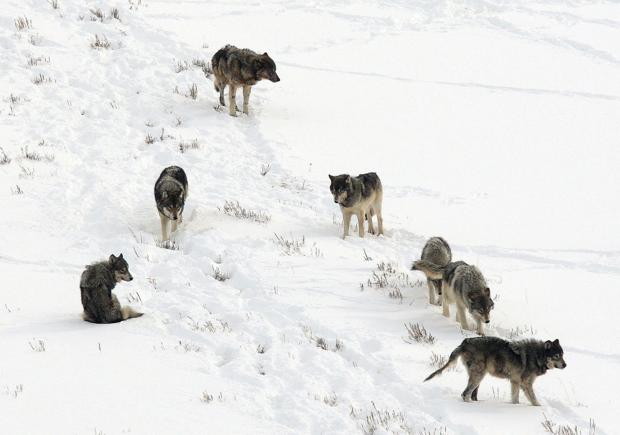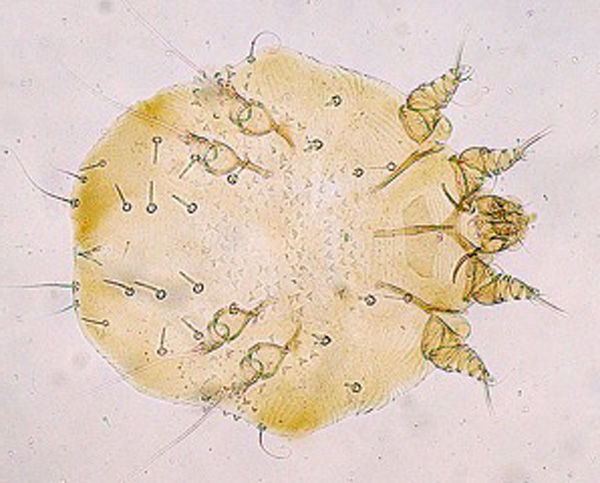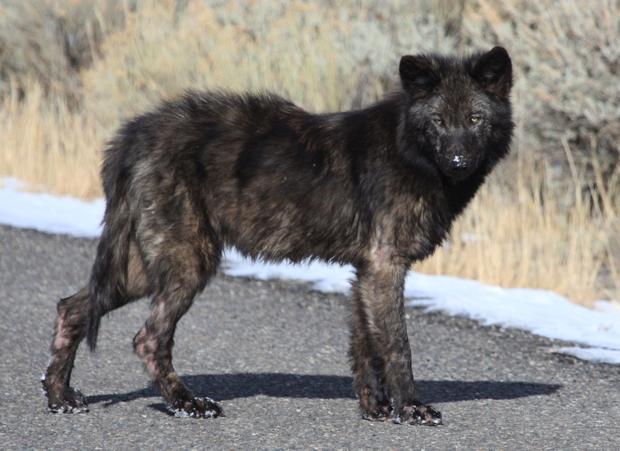It’s not as healthy to be a lone wolf, especially if you have mange.
That’s the conclusion of a recently published study of Yellowstone National Park wolves that examined survival of animals suffering from an infestation of itch-causing mites. “There are lots of other examples — humans being one of them — that animals benefit from cooperative care,” said Emily Almberg, a research scientist at Penn State and the lead author of the study. “But it was a little surprising that a mangy individual could survive as well as a healthy wolf.”
That’s right, wolves infected with mange that were living in a pack with at least five other healthy wolves had the same rate of death as their healthy companions, the study found.

Mite infections that are localized are survivable, but large infestations can be deadly for several reasons. The itchiness may distract the animal from feeding, drinking and sleeping. Loss of hair, especially in the winter, can mean dangerous heat loss. The outbreaks can also cause secondary infections. The severity of mange seems to be widely variable as does the duration.
So how does being in a pack help a mangy wolf survive? Almberg said that’s a bit difficult to nail down, but the prevailing theory is that the pack’s ability to feed the sick animal may keep it healthy enough to survive the mite infestation. Without a pack, especially a larger pack, a wolf is more susceptible to going hungry or being killed by rival wolves from other packs.
But being in a larger pack would also seem to be more dangerous for the pack, since one sick individual could infect others. “That’s sort of dogma within disease ecology,” said Paul Cross, a disease ecologist with the U.S. Geological Survey in Bozeman who participated in the wolf study. “The cost of larger groups is more disease. It’s counterintuitive except where large groups were helpful in terms of better survival.”
Such benefits may be common among other cooperative carnivores, Cross said, such as African lions and killer whales.
Mortality rates from those early outbreaks were higher, yet some wolves never contracted the mite or seemed to have some type of immunity, although why is not understood, Almberg said. As Yellowstone’s wolf numbers have dwindled, so did mange outbreaks to the point that scientists thought maybe the mites had died out. But they are capable of surviving on a variety of furbearers, so it was only a matter of time before wolves were infected again.“In cooler, moist temperatures, the mites seem to do better,” Almberg said. “The winter of 2013 was really bad, but we don’t know why.”
Almberg also noted that recent severe outbreaks of mange seem to target younger animals. “This pattern is consistent with either acquired immunity or a ‘frailty effect’ where particularly susceptible individuals (due to genetics or general condition) are selected against early on in the epidemic,” according to the Yellowstone Wolf: Project Citizen Science’s website.

Pets like cats and dogs can also contract mange. The common treatment is an oral dose of medicine, a practice that’s not practical in the wild. So, mange will continue to live on among Yellowstone’s wolves, coyotes, foxes and now even grizzly and black bears.
“It’s an old, old, old parasite,” Almberg said. “It’s globally distributed. It was present in North America before it was introduced in the West. And there’s no practical way to treat it in the wild.”
source
That’s the conclusion of a recently published study of Yellowstone National Park wolves that examined survival of animals suffering from an infestation of itch-causing mites. “There are lots of other examples — humans being one of them — that animals benefit from cooperative care,” said Emily Almberg, a research scientist at Penn State and the lead author of the study. “But it was a little surprising that a mangy individual could survive as well as a healthy wolf.”
That’s right, wolves infected with mange that were living in a pack with at least five other healthy wolves had the same rate of death as their healthy companions, the study found.

Yellowstone
National Park wolves, some of which have mange, were just as likely to
survive an infestation of mites, which creates hair loss and often
secondary infections, as a healthy control wolf if they lived in a large
pack, according to a recently published study.
Mighty mites
The tiny mites that cause mange were spread to the Northern Rockies by state wildlife veterinarians in 1909 as way to eradicate coyotes and wolves. The female bugs burrow into furbearers’ skin, lay eggs and cause itching and often an allergic reaction or rash. The infection is visible when the animal loses hair around the infection site, often from continual scratching.Mite infections that are localized are survivable, but large infestations can be deadly for several reasons. The itchiness may distract the animal from feeding, drinking and sleeping. Loss of hair, especially in the winter, can mean dangerous heat loss. The outbreaks can also cause secondary infections. The severity of mange seems to be widely variable as does the duration.
So how does being in a pack help a mangy wolf survive? Almberg said that’s a bit difficult to nail down, but the prevailing theory is that the pack’s ability to feed the sick animal may keep it healthy enough to survive the mite infestation. Without a pack, especially a larger pack, a wolf is more susceptible to going hungry or being killed by rival wolves from other packs.
But being in a larger pack would also seem to be more dangerous for the pack, since one sick individual could infect others. “That’s sort of dogma within disease ecology,” said Paul Cross, a disease ecologist with the U.S. Geological Survey in Bozeman who participated in the wolf study. “The cost of larger groups is more disease. It’s counterintuitive except where large groups were helpful in terms of better survival.”
Such benefits may be common among other cooperative carnivores, Cross said, such as African lions and killer whales.
Mange in YNP
Yellowstone wolves suffered their first significant mange outbreak in 2007, 12 years after they were first reintroduced to the park. Since then, pack and wolf numbers have fallen, and so has the rate of mange infection. Almberg said only a couple of wolves are noticeably infested this year as wolf numbers have stabilized at 104 wolves in 11 packs, not counting this spring’s pups.Mortality rates from those early outbreaks were higher, yet some wolves never contracted the mite or seemed to have some type of immunity, although why is not understood, Almberg said. As Yellowstone’s wolf numbers have dwindled, so did mange outbreaks to the point that scientists thought maybe the mites had died out. But they are capable of surviving on a variety of furbearers, so it was only a matter of time before wolves were infected again.“In cooler, moist temperatures, the mites seem to do better,” Almberg said. “The winter of 2013 was really bad, but we don’t know why.”
Almberg also noted that recent severe outbreaks of mange seem to target younger animals. “This pattern is consistent with either acquired immunity or a ‘frailty effect’ where particularly susceptible individuals (due to genetics or general condition) are selected against early on in the epidemic,” according to the Yellowstone Wolf: Project Citizen Science’s website.

The tiny mite known as Sarcoptes scabiei is the one responsible for causing mange in Yellowstone wolves.
Contamination
Infections can come from visiting kill sites where mites have survived on a dead animal or been transferred by an infected animal. The mites can also be transferred by wolf interactions via breeding, pack social contact or fights.Pets like cats and dogs can also contract mange. The common treatment is an oral dose of medicine, a practice that’s not practical in the wild. So, mange will continue to live on among Yellowstone’s wolves, coyotes, foxes and now even grizzly and black bears.
“It’s an old, old, old parasite,” Almberg said. “It’s globally distributed. It was present in North America before it was introduced in the West. And there’s no practical way to treat it in the wild.”
source


